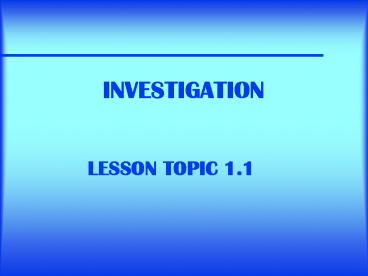INVESTIGATION - PowerPoint PPT Presentation
1 / 28
Title:
INVESTIGATION
Description:
Leaking stuffing tubes. Types of Investigations. Secondary Investigation Continued ... individual dogs, open the hinge side first. Investigating Watertight ... – PowerPoint PPT presentation
Number of Views:757
Avg rating:3.0/5.0
Title: INVESTIGATION
1
INVESTIGATION
- LESSON TOPIC 1.1
2
(No Transcript)
3
Enabling Objectives
- Identify the need for principles of, and
equipment required to investigate for fire,
flooding and structual damage IAW NSTM 079 VOL 2
and NTTP 3-20.31, COMNAVSURFORINST 3541.1, and
NSTM 555. - Identify proper procedures for investigating and
safely entering watertight closures
IAW NSTM 079 VOL 2 and NTTP 3-20.31,
COMNAVSURFORTINST 3541.1, and NSTM 555.
4
Purpose of Damage Control Investigation
- To investigate and provide an orderly relay of
vital information from station to station - Allows repair teams not at the scene of the
damage to evaluate ships capabilities and take
corrective action accordingly
5
Damage Control Investigation
- When to Investigate?
- Fire
- Flooding
- Collision
- Any type of damage
6
Types of Investigations
- Preliminary Investigation
- Report the obvious damage!
- Fire
- Smoke
- Flooding
- Loss of Power
- Ruptured piping, damage to fittings
- Holes in decks or bulkheads
- Drop in pressure gauges
7
Bulkhead Repairs
8
Sagging Overhead
9
Hot Spot on WTD
10
Panting Bulkhead / Warped Bulkhead
11
Charlie Fire on Switchboard
12
Drop in Pressure Gages
13
NOTE These are symptoms of dangerous condition
and prompt remedial action must be taken if the
ship is to survive
14
Types of Investigations
- Secondary Investigation
- Report the unseen or hidden damage!
- Severed electrical cables
- Cracks and split seams
- Leaking stuffing tubes
15
Types of Investigations
- Secondary Investigation Continued
- Fully detailed structural reports must be made at
this time - Note- Investigators reports will have a direct
impact on the action to be taken to localize and
control damage
16
Investigator Requirements
- KNOW YOUR SHIP!!!
- Start learning your ship the day you report
onboard - Learn your ships systems and fundamentals
- Complete your PQS involve yourself with training
17
Investigator requirements on Shipboard
Systems
- Compartmentation
- Firemain
- Fuel
- Fresh Water
- AFFF
- Fire Fighting Systems
- Halon
- CO2
- AFFF
18
Principles of Investigation
- Thoroughly
- Look for all damage, hidden or unseen
- Cautiously
- Be alert, wear an OBA/SCBA
- Report
- Location
- Type and extent of damage
- Repeat
- Until properly relieved, until the emergency is
over
19
OBA with audio projection set or SCBA
Fire finder
Wifcom
Battle helmet
Rubber gloves 7500 volt and leather gloves
shell
Dogging wrench
Flashlight
wrench-adj 15
T Wrenches 3/8,1/2,3/4
Tape sounding 50ft 2ea
20
Investigator Kit and Equipment
- Continued Investigator kit
- Tool bag, Belt
- Message blanks/ ball point pens, grease pencils
- Spare OBA Canisters
21
Investigating Watertight Closures and Fittings
- (1.) Check for heat
- Use the Fire Finder
if ship is equiped. - If Not use back of hand
approximately
½ inch from surface. - (2.) Check for flooding
- Look for condensation on door
or bulkhead. Water on deck.
22
Investigating Watertight Closures and Fittings
- (3.) Check for pressure/vacuum
- Loosen and shake WT closure
- Never loose control
of
closure or fitting - (4.) To open a WTD with
- individual dogs, open the
hinge side first.
23
Investigating Watertight Closures and Fittings
- (5.) To open a scuttle turn hand wheel a ¼ turn,
shake and continue until scuttle is open. - ALWAYS USE CAUTION UNTIL THE COMPARTMENT OR
FITTINGS ARE SUSPECTEDTO BE SAFE TO CONTROL THE
SPREAD OF DAMAGE
24
Reporting Procedures
- 1. Prompt reports are essential.
- 2. If any casualty is detected while
investigating, the following actions should be
taken.
25
FIRE
- 1. One investigator notes vital information to
include compartment number, frame numbers, and
nature of the casualty - 2. The investigator then reports information to
repair station and when possible the On Scene
Leader - 3. The other investigator remains at the scene
and initiates fire fighting efforts when
practical, or establishes/maintains Fire/Flooding
boundaries
26
Flooding
- 1. Same as Fire. Report it!
- 2. One investigator remains at the scene and
secures the compartment by checking all
watertight fittings when practical. Sets
boundaries
27
Reporting ProceduresContinued
- When relieved by fire party or the repair party,
the investigators return to their investigating
duties.
28
Summary and Review
- Purpose of Investigations
- When to investigate
- Types of investigation
- Investigator Requirements
- Principles of investigation
- Equipment
- Investigation of WT closures
- Procedures for reporting































